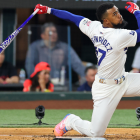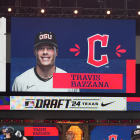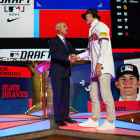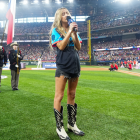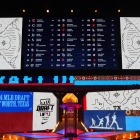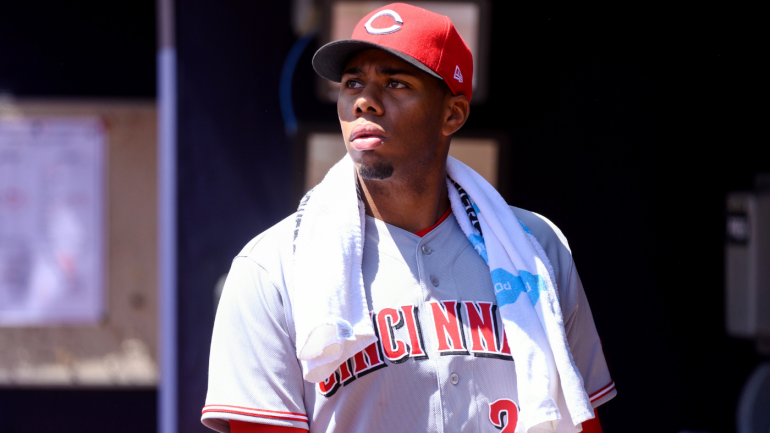
Cincinnati Reds right-hander Hunter Greene has had quite the introduction to the majors. In his first start, he faced the defending champion Atlanta Braves. In his second, he had to go against the Los Angeles Dodgers, the team the Braves defeated in last fall's National League Championship Series. Both starts took place on the road. Welcome to The Show, rook, indeed.
Yet Greene has held his own so far. In 10 innings, he's surrendered five earned runs on nine hits and two walks. He's struck out 13 of the 42 batters he's faced, or 31 percent. He even set a record of sorts against the Dodgers, throwing 39 pitches that were clocked at 100 mph or greater. That's the most in the pitch-tracking era, edging New York Mets ace Jacob deGrom, who delivered 33 such pitches last June, per ESPN.
Hunter Greene, 102mph ⛽️ pic.twitter.com/lPGeVGqKry
— Rob Friedman (@PitchingNinja) April 17, 2022
There's no doubt that Greene, the No. 2 pick in the 2017 draft, has elite arm strength. Prior to his debut, a rival talent evaluator joked to CBS Sports that 100 mph for him is akin to 95 mph for the average pitcher. Truth is often disguised in jest, and that's the case here. Greene entered Monday averaging 100 mph on his fastball for the season, the highest among qualified starters. The gap between Greene and second-place Sandy Alcántara (2.8 mph) is equal to the one between Alcántara and No. 18.

CBS Sports HQ Newsletter
Your Ultimate Guide to Every Day in Sports
We bring sports news that matters to your inbox, to help you stay informed and get a winning edge.
Thanks for signing up!
Keep an eye on your inbox.
Sorry!
There was an error processing your subscription.
MLB's hardest-throwing qualified starters, 2022
| Pitcher | Team | Fastball velocity (avg) |
|---|---|---|
Hunter Greene | CIN | 100 mph |
Sandy Alcántara | MIA | 97.2 mph |
Carlos Rodón | SF | 97.1 mph |
BOS | 96.8 mph | |
NYM | 96.4 mph |
Greene's fastball has shown more than top-end velocity, too. His induced vertical break ranks in the 72nd percentile among those qualified starters. His horizontal break ranks in the 83rd percentile among the right-handers. Based only on those traits, Greene's fastball compares favorably to the one thrown by Justin Verlander.
Tom Seaver used to quip that the fastball is both the most and second-most important pitch in the game. It's fair to write, then, that Greene is one of the most exciting and promising young starters in the majors based on his fastball alone. He's only two starts into his career, though, and that means it's natural for him to have things to work on. Below, CBS Sports has highlighted two such areas that, with some additional growth, could see Greene develop into one of the best pitchers in the sport.
1. Secondary pitches
One of the questions scouts have had about Greene involves the quality and consistency of his secondary pitches. Us spending hundreds of words on him without mentioning either his slider or changeup is a tip-off that they remain works-in-progress, even as they account for more than a third of his offerings.
Greene's slider has shown the greater promise of the two. He's primarily used it as a chase pitch, and so far it's generated eight whiffs and nine chases on 17 swings. Here are a few from his first start:
Hunter Greene, White Castle Special. 🤮🍔🍔🍔 pic.twitter.com/HacBQMibu7
— Rob Friedman (@PitchingNinja) April 10, 2022
Greene's changeup, meanwhile, is functionally a slower fastball that he's had trouble locating in competitive locations. Batters have fouled-off the pitch on four of their six swings taken against it, having whiffed and chased just once apiece. At this stage, Greene's cambio has utility only in the sense that it provides another look. He'll need to continue to polish it if he wants to make it so much as an average offering.
We've written before about the recent changes to starting pitchers' workloads and pitch mixes. Greene is, at present, a two-pitch pitcher who has one offering he can reliably throw within the zone. If we were writing this in 2003 or 2008 or, jeez, even 2013, we would've concluded that he was likely to end up in the bullpen if he didn't develop an arsenal capable of combating a lineup three or four times in a given night. Instead, the transformations to the role suit Greene's capabilities to a tee.
That doesn't mean Greene should rest with regards to his secondaries. It would only make sense for him to throw his slider within the zone more frequently -- an act that, to his credit, he's shown some feel for -- as a means of protecting against batters cheating on his fastball. He should also continue to work on his changeup, since there's never a risk of having too many quality pitches at one's disposal.
Heck, there may even be room for improvement with an aspect of Greene's heater.
2. Fastball location
We've established that Greene has a high-quality fastball. Here's another way of thinking about it. Thus far this season, he has the second-highest swing-and-miss rate on his heater of any qualified pitcher, behind only Alek Manoah, with batters whiffing on 39.6 percent of their swings taken against it. The catch is that while hitters aren't touching his fastball often, they're doing real damage when they do.
Greene's fastball has a .333 batting average against to go with a .704 slugging percentage against. Those numbers come in a small sample, of course, but they're accompanied by an average exit velocity of 95 mph. What's the deal? Part of it, in our estimation, is Greene's location. Take a look at his fastball heat map:
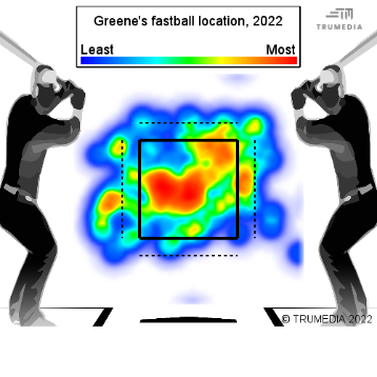
As odd as it sounds, throwing a lot of pitches that end up over the middle isn't always the worst thing. Legend has it that the Chicago White Sox once told Matt Thornton to throw his cutter over the middle because no one could hit it anyway. More recently, Robbie Ray's breakout was attributed in part to his willingness to let his heater eat in the middle of the zone. Besides, location itself is just part of the equation; the pitch's velocity and flight path matter, too. An offering with good speed and wiggle, so to speak, that happens to cross over the heart of the plate is more likely to succeed than one with a less impressive speed and movement profile.
With all that noted, we do wonder if Greene will eventually shift his target north with greater frequency. We invoked the Verlander comparison earlier. Here's his heat map:
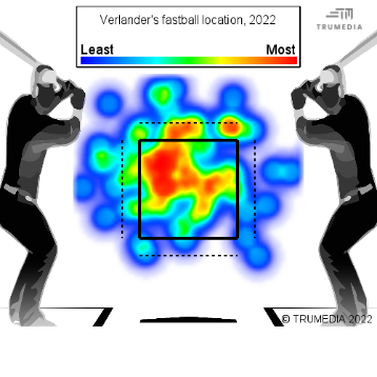
It would be silly to read too much into a single game's worth of fastball locations, but it's worth pointing out that Verlander elevated his heater more often than Greene. This is the era of the high fastball, a counteract to the powerful uppercut swings unleashed across the land. Given the characteristics of Greene's heater, he would seem well-suited to overpower hitters in that neighborhood.
Perhaps Greene will lean into that aspect heading forward. Even if he doesn't, he's already achieved appointment viewing status.












